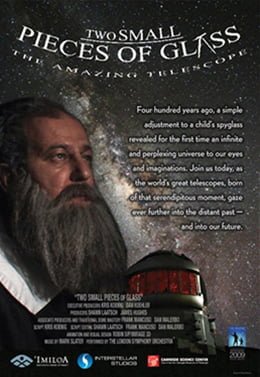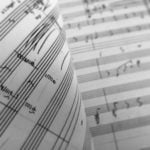Developed in the fulldome format as an educational planetarium show, Two Small Pieces of Glass was produced in affiliation with the International Year of Astronomy. With primary funding by the National Science Foundation (NSF), it represents one of the prestigious projects affiliated with this global celebration of astronomical knowledge.
The show was developed by the Interstellar Studios and the Imiloa Astronomy Center
Its production was intertwined with that of the feature-length documentary, 400 Years of the Telescope. As a result, a modified version of the themes initially recorded for this documentary was seamlessly integrated into Two Small Pieces of Glass. The soundtrack, recorded at Abbey Road Studios with the London Symphony Orchestra, was the creation of British composer Mark Slater.
The show was the most played planetarium show for three consecutive years
Why Two Small Pieces of Glass?
Four centuries ago, an innovative tweak to a child’s plaything brought a vast and intricate universe into focus. This humble device, a spyglass with two convex lenses, became the inspiration for the title of the film “Two Small Pieces of Glass“. The protagonist of this story is none other than Galileo (1564 – 1642), an Italian scholar proficient in astronomy, physics, and engineering. While he was not credited with the invention of the telescope, Galileo was the first known individual to point this visionary equipment towards the night sky.
Observations borne out of this extraordinary endeavor revealed that the universe was not as flawless and unchangeable as once believed; through Galileo’s lenses, lunar mountains were observed, Venus’ transition through phases were tracked, moons of Jupiter were discovered, and even sunspots were studied. Thusly, these two small pieces of glass quite literally opened a window to a dimension that proved to be more intricate than collectively perceived.
In present times, giant telescopes, descendants of that chance find, stare wider and further into the cosmic past and also foretell our future.
A Walkthrough ‘Two Small Pieces of Glass: The Amazing Telescope’
Imagine the scene: At a local star gazing event, two high school students experience a journey of discovery. Their curiosity about the universe meets the wisdom of a local female astronomer. Guided by her extensive knowledge, they learn how the ingenious invention of the telescope has bravely bridged our understanding of ourselves and our relationship with the cosmos. As these young minds uncover, telescopes have been instrumental in constant evolution of our grasp on the mysteries of the universe.
Our teen protagonists, together with everyone in the planetarium, are enraptured as they delve into the seemingly unreachable depths of space. The astronomer’s telescope illuminates vivid planetary wonders: the stark Galilean moons, the vibrant, enigmatic rings of Saturn, and the mesmerizing spiral formations of distant galaxies.
Their conversation with the astronomer is enlightening as it uncovers the milestones ushered in by the telescope. They are introduced to the epic discoveries and groundbreaking theories of noteworthy astronomers like Galileo, Huygens, Newton, and Hubble. These pioneers, our two students learn, have paved the way to our current understanding of the universe through their ground-breaking research and observations.
Astronomy compels the soul to look upward, and leads us from this world to another.
Plato
Celebrating the Stars: The Impact of ‘Two Small Pieces of Glass: The Amazing Telescope’ on Astronomy Education
Two Small Pieces of Glass: The Amazing Telescope was met with overwhelming positive reception from audiences worldwide. The show’s ability to educate while entertaining struck a chord with viewers, making it a favorite among planetarium-goers.
From the United States to Japan, audiences were captivated by the show’s stunning visuals and immersive storytelling. The use of cutting-edge technology to project the cosmos in stunning detail was praised by viewers, who felt as if they were journeying through the universe themselves.
In Europe, the show was lauded for its educational value. Teachers and students alike appreciated the way it made complex astronomical concepts accessible and engaging. The show was frequently used as an educational resource in schools, further contributing to its popularity.
The soundtrack, recorded by the London Symphony Orchestra, was another aspect of the show that was highly praised. The music added an emotional depth to the viewing experience, enhancing the sense of awe and wonder. Many viewers commented on how the soundtrack elevated the show, making it a truly immersive experience.
In addition to the public, the show also received positive feedback from the scientific community. Astronomers and educators praised the show for its accuracy and its ability to inspire interest in astronomy. The show’s success in making astronomy accessible to the general public was seen as a significant achievement.
Overall, the global reception of Two Small Pieces of Glass: The Amazing Telescope was overwhelmingly positive. Its combination of stunning visuals, engaging storytelling, and educational content, all enhanced by a beautiful soundtrack, made it a hit with audiences around the world.
Listen to the Music of Two Small Pieces of Glass
The original film is in fulldome 4K format, but you can also watch it in a scaled down 16:9 ratio.
Two Small Pieces of Glass is available in English, Spanish, French, Italian, German, and Russian languages.
Technical Parameters
- Release: 2009
- Genre: Astronomy
- Format: Fulldome
- Resolution: 4K
- Running Time: 25 mins
- Production technologies: CG, Green screen, Live action
- Audio format: 5.1
- Languages: English, German, French, Italian, Spanish

Distributors
Showing at
- Cradle of Aviation Museum
- Fiske Planetarium
- John C. Wells Planetarium
- UAA Planetarium
- Illinois State University
- Museum of Natural Sciences
- Dooley Planetarium
- University of Southern Maine
- High Point University
- Kalamazoo Valley Museum


Pingback: Recording at Abbey Road with the London Symphony Orchestra - Mark Slater